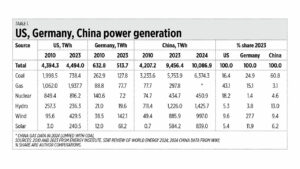China energy and infra innovations

BEIJING — The other day I rode on the world’s fastest train, and I was amazed by its speed and comfort. My hosts brought me to Hebei province by car, across many big mountains and hills, to see a big pumped hydro project, then coming back we took the train from Chengde to Beijing.
On that trip I saw many things. Nine road tunnels one way alone, the longest nearly three kilometers-long, and coming back we entered a five kilometers-long tunnel. Smooth, wide, and well-paved toll roads and provincial roads. Few flat agricultural lands that competed with industrial, commercial, and residential land, so there were many greenhouse farms to optimize land use. And from the toll roads I saw decent rural farmers houses, no barung-barung-style houses and no hand tractors, only medium-size to big tractors.
Hydro power is China’s second largest source of electricity. Last year, 1,426 terawatt-hours (TWh) were generated by hydro. In 2023, China’s power generation was twice that of the US and 18 times that of Germany. As Germany added more wind and solar power to its mix, their overall power generation declined from 633 TWh in 2010 to 514 TWh in 2023 (see Table 1).
When it comes to battery energy storage systems (BESS) in 2023, Germany had 1.7 gigawatts (GW), US had 15.8 GW, and China had 27.1 GW, which further rose to 34.7 GW in 2024.
The Fengning pumped hydro power project in Hebei province — producing 3,600 MW of electricity and owned by the State Grid Corp. of China — is the largest pumped hydro in the world and was finished only in August 2024. It involves two huge lakes and dams — I was aghast at their size and power — and 12 turbines. We went down 500 meters below the surface to see the control area.
We should pursue more investments in hydro power projects, impounded water and/or pumped storage in the Philippines because we have many floods every year. A large volume of water from our rivers just drains directly into the sea instead of being impounded and stored for electricity, drinking water, and irrigation purposes.
Finance Secretary Ralph G. Recto, in his keynote speech before over 300 global investors at the Philippine Stock Exchange’s (PSE) “InvestPH 2025” forum on March 19, said that the Philippines is “the right place and the right time to invest.” He emphasized the country’s fast growth in the last three years, and the forecast growth this year and the next.
Big investments in non-intermittent energy projects like hydro, gas, and coal would be needed precisely because of the expected high-power demand from such high economic growth projections. We should not disappoint the investors who come here with frequent yellow-red alerts in our power supply.
Big investments in large train projects like high-speed rail (HSR) are also needed. Many Asian countries are able to sustain their industrialized status partly because they have long HSR systems, led by China whose trains travel up to 350 kilometers per hour (kph, see Table 2).
China has become an industrialized and innovative country, a first world economy pretending to be third world. It is our neighbor, it is the largest source of our imports especially of the needed trucks, buses, gadgets, and appliances, among others. In 2024, our total trade (exports plus imports) with all countries was $200.6 billion, of which $42.2 billion was with China, more than the share of Japan and the US combined which is $40.7 billion.
We should trade more, learn more, cooperate more with China. In energy development especially, both in power generation and transmission. We should aspire for more tangible wealth, material prosperity, and modernity for our people.
Bienvenido S. Oplas, Jr. is the president of Bienvenido S. Oplas, Jr. Research Consultancy Services, and Minimal Government Thinkers. He is an international fellow of the Tholos Foundation.




